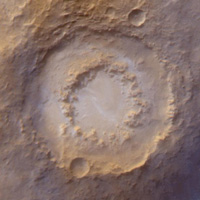 |
The Frosted Craters of Northern
Spring and Southern Autumn - Lowell Crater from NASA's
Planetary Photojournal.It is spring in the northern
hemisphere, and frost that accumulated during the most recent
6-month-long winter has been retreating since May. It is
autumn in the southern hemisphere, and frost was seen as early
as August in some craters; later the frost line moved farther
north, and we began to see frost in Lowell Crater in
mid-October.
| |
People could land on Mars in the next 20 to 30
years provided scientists can find water on the red planet, the head of
NASA's surface exploration mission said on September 16.
Two partially solar-powered "robot geologists" -- Mars Exploration
Rovers, or MERs -- have been trundling across 3 miles of the planet and
into craters since January, beaming back data about the makeup of what
scientists believe is Earth's sister planet.
Asked how long it could be before astronauts land on Mars, Arthur
Thompson, mission manager for MER surface operations said, "My best guess
is 20 to 30 years, if that becomes our primary priority."
The two MER robots, dubbed Spirit and Opportunity, have found ancient
evidence that water was once plentiful -- important for scientists hoping
to know if there was once -- or could still be -- life on Mars.
Without water, the dream of sending astronauts to the often dusty
planet, which has rust-colored rocks and where the sky is red and sunsets
are blue, couldn't unravel.
"If we cannot find water,it really makes it difficult to send humans.
Water is the key," said Thompson, who was attending a mining engineers'
conference.
Such a mission would take 11 to 12 months to get to Mars and it would
be impossible to carry enough water for the astronauts, plus the water
needed to make rocket fuel for the return journey, to cool the spacecraft
and to generate energy.
Thompson said scientists had found a canyon on Mars "that makes the
Grand Canyon look like a small canyon," where water could still be
present.
"There are indications that there is actually water that seeps out the
side of the canyon, and going down the side it evaporates. We believe it's
an ongoing process," he said.
Three satellites now orbiting Mars
are constantly gathering information, and Thompson said, "If there is
water, we believe the chances of finding life are greatly
increased."
(Agencies) |
9月16日,美國國家宇航局地表探測任務小組的負責人表示,如果科學家們能夠在火星上找到水源的話,人類就可能在20到30年后登上火星。
兩臺部分由太陽能驅動的“機器人地質學者”——火星探測漫游者(簡稱為MERs)自1月份以來已經在火星上移動了3英里,并且進入了火星表面的環形山,同時向地球發回有關火星組成結構的數據。科學家們把火星視為地球的姊妹星。
當問到宇航員還需要多久才能登上火星時,“火星探測漫游者”地表探測任務小組負責人亞瑟·湯普森說:“如果我們把登上火星作為首要目標的話,我預計最快要20到30年。”
這兩位火星探測漫游者分別被命名為“勇氣號”和“機遇號”,他們發現了可以證明火星上曾經存在大量的水的古老證據,這對想要知道火星上是否曾經存在或仍然存在生命的科學家來說是非常重要的。
火星上塵土飛揚,巖石是鐵銹色的,天空是紅色的,日落是藍色的。如果沒有水,把宇航員送上火星的夢想就無法實現。
湯普森在參加一個采礦工程師會議時說:“如果我們找不到水的話,把人類送上火星是非常困難的。水是關鍵因素。”
把宇航員送到火星上的任務需要花11到12個月的時間。宇航員們無法帶夠所需的水。此外,在返回地球時,需要用水來生成火箭燃料、冷卻太空船并產生能量。
湯普森說科學家們在火星上發現了一個峽谷,與這個峽谷相比,“美國大峽谷就顯得很渺小了”。這個峽谷現在仍然可能有水。
他說:“有跡象表明確實有水從峽谷的一側滲出,并沿著這一側流淌蒸發。我們相信這個過程還在進行中。”
三顆圍繞火星運行的衛星正不斷地收集信息。湯普森說:“我們相信如果發現水的痕跡,發現生命的可能性就大大增加了。”
(中國日報網站譯) |
